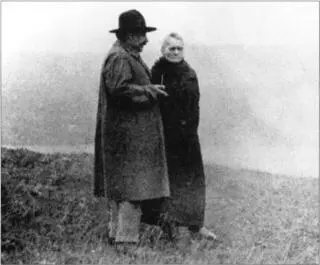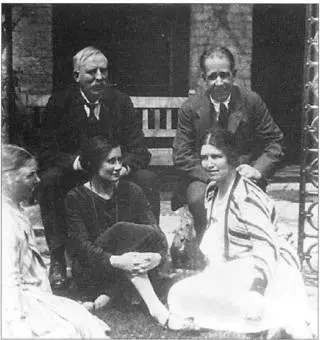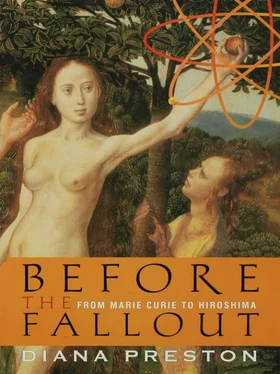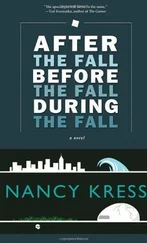
Albert Einstein and Madame Curie
Bohr studied at the University of Copenhagen, where physics became his passion. He was intrigued by the new discoveries: Rontgen’s x-rays, Bec-querel’s rays, the discovery of radioactivity, Thomson’s electron, and Rutherford’s identification of alpha and beta radiation. For his doctoral thesis he explored the behavior of electrons in metals. His findings were so new and unusual that, as with Marie Curie when she was examined on her thesis, no one was equipped to question them. Bohr then decided he wished to study with J. J. Thomson at the Cavendish Laboratory and arrived in Cambridge in the autumn of 1911. However, shortly before Christmas he heard Rutherford speak at the annual Cavendish dinner about his discovery of the nucleus. Bohr was mesmerized and the following April moved to Manchester University.
Bohr found the atmosphere there exhilarating. Rutherford encouraged his young scientists to gather every afternoon for tea. Perched on a stool, his great voice booming out, he urged everyone to speak up, provided they “made sense” and avoided “pompous talk.” One of the subjects most eagerly debated was the structure of the atom. Bohr accepted Rutherford’s model of the atom as a miniature solar system, with electrons orbiting around the nucleus like planets around the sun, but recognized an inherent flaw. According to Newtonian physics, which saw the world in mechanical terms, the whirling negatively charged electrons should have gradually dissipated their energy through their movement. As a result, they should have collapsed into the positively charged nucleus in the heart of the atom that was pulling them to their doom, gradually shrinking anything and everything. Yet clearly this did not happen. It was a mystery because, as Rutherford acknowledged, not enough was yet known about either the orbiting electrons and their paths or the nucleus.
Bohr reasoned that, if Rutherford’s model was correct, some kind of stabilizing or balancing effect must be at work within the atom. Over the next eighteen months he set out to prove this, turning to the quantum theories of Planck and Einstein. Unlike Planck, who was at the time developing his theory further and even coming around to believing in it himself, Bohr did not worry that the theory could not be properly explained. What mattered was applying it. His guiding principles were that science needed paradoxes to progress, and that, provided they were well-founded, seemingly contradictory ideas should not be changed but reconciled. A story frequently related by Bohr exemplified his mental flexibility. A visitor, surprised to see a horseshoe above the entrance to Bohr’s house, asked whether Bohr really believed it would bring good luck. “Of course not,” Bohr replied, “but I am told it works, even if you don’t believe in it.”
Bohr instinctively accepted the existence of quanta and looked for ways to fit a theoretical structure to observed experience of atomic behavior. By late June 191 2, less than three months after arriving in Manchester, he had developed an initial version of what would become known as the “Rutherford-Bohr” model of the atom and which, once accepted, would be used by scientists ever after. Over the next eighteen months, during which he returned to Denmark and married, Bohr refined and developed his ideas further for publication in a trilogy of papers on the “Constitution of Atoms and Molecules.” He applied quantum theory to matter as well as energy. The heart of Bohr’s insight was that the orbits in which electrons travel around the nucleus are specified by quantum rules that provide each orbit with a defined level of energy. While orbiting, an electron suffers no energy loss. Building on this, Bohr envisioned successive layers of electrons “binding” into a structure around the nucleus until a stabilizing electrical neutrality was achieved. By a “quantum leap,” electrons could switch orbits within an atom, emitting or absorbing energy in bursts.

Niels and Margrethe Bohr (right), Ernest Rutherford (left) and Mary Rutherford (seated far left)
Bohr’s theories not only offered a solution to the problem of the stability of the atom. He was also nudging toward the conclusion that the structure of the rings of orbiting electrons, and how these built up, held the key to understanding the hierarchy of elements and how and why they could combine to form new ones.
Rutherford, who initially found Bohr’s ideas ingenious if hard to visualize, was his mentor throughout. He regarded the Dane as “the most intelligent chap I’ve ever met” and admired his disregard for the old orthodoxies. He welcomed his theory of electrons, without yet giving it his formal endorsement. As a confirmed experimentalist, he warned Bohr against placing too much credence on theory alone. He also warned him not to be long-winded when he published his findings: “It is the custom in England to put things shortly and tersely in contrast to the Germanic method where it appears to be a virtue to be as long-winded as possible.” Bohr dug in his heels. Rutherford offered to edit Bohr’s work for publication. The Dane hurried to Manchester to defend his work not just paragraph by paragraph but right down to the complex structure of his extensive sentences, which, he insisted, were essential to the detailed logic of his case, even if initially confusing. It was one of the few battles Rutherford ever lost. He submitted with good grace, telling his protégé he never thought he would prove so obstinate.
The scientific community responded to Bohr’s theories with everything from enthusiasm to incredulity. According to a letter from the Hungarian scientist Georg Hevesy to Rutherford, when Einstein learned of them his “big eyes… looked bigger still, and he told me ‘Then it is one of the greatest discoveries.’” Others were openly skeptical, including Thomson, who was developing his own, different model of the atom. In Germany a number of physicists swore “to give up physics if that nonsense was true. “Yet supporting evidence was emerging all the time. Some of it was provided by another of Rutherford’s students, the obsessively hardworking, Eton-educated Harry Moseley, who had arrived in Manchester in September 1910.
Moseley was using x-rays, the penetrating radiation discovered by Rontgen about whose nature scientists were still arguing, to explore variations between elements. To do this, he built an ingenious piece of equipment resembling a toy train with a number of wagons. On each of these he placed a specimen of the element he wanted to examine and then, by winding silk cords on brass bobbins, moved his “train” along a pair of rails inserted inside an x-ray tube so that each of his elements, in turn, was bombarded by cathode rays. When he examined the spectra his specimens produced, Moseley found that they differed according to a regular pattern. The difference between elements seemed to depend on a “something” which Moseley interpreted as a difference of one unit charge on the nucleus—in other words, a difference of one in the number of electrons possessed by the atom. He knew this would support Bohr’s theory of the atom and the Dane’s intuition that it was the number of electrons that determined the chemical and physical characteristics of matter.
In late 1913 Moseley left for Oxford University to continue his research there but kept Rutherford and Bohr abreast of his findings. He worked through the naturally occurring elements, from the lightest, hydrogen, to the heaviest, uranium, arranging them in the light of his experimental findings in a revised periodic table. Until this time elements had been ranked by their atomic weight. This practice went back to the days of the scientist John Dalton, who, in the early nineteenth century, had developed a theory attaching experimentally determined weights to chemical elements. The idea of a periodic table had been introduced in 1869 by the Russian Dmitry Mendelevev, who had noticed that when the elements were arranged in order of their atomic weights, they could be grouped according to their chemical behavior.
Читать дальше














